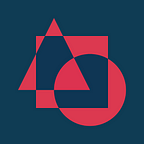Blockchain Legos
Hi! Welcome back.
In this opportunity I wanted to talk a little bit about the NFT I use as an avatar in many of my social media platforms.
I like it so much because every time I see it, it makes me think of the Scalability Trilemma and the future of L1 blockchains.
The trilemma states that it’s not possible to achieve all three concepts by using “simple” techniques. But don’t take it from me, here’s a part of Vitaliks post explaining everything you need to know for now.
The scalability trilemma says that there are three properties that a blockchain try to have, and that, if you stick to “simple” techniques, you can only get two of those three. The three properties are:
Scalability: the chain can process more transactions than a single regular node (think: a consumer laptop) can verify.
Decentralization: the chain can run without any trust dependencies on a small group of large centralized actors. This is typically interpreted to mean that there should not be any trust (or even honest-majority assumption) of a set of nodes that you cannot join with just a consumer laptop.
Security: the chain can resist a large percentage of participating nodes trying to attack it (ideally 50%; anything above 25% is fine, 5% is definitely not fine).
Because of this, many blockchain researchers (not only from the Ethereum ecosystem) have dedicated years of their life trying to develop innovative technologies to get all three of them.
Even if those technologies are actually possible to create (the trilemma isn’t a law, it’s simply a way to visualize the problem at hand) it’s something really hard to work out. That’s why Ethereum core developers simply decided to leave scalability improvements at the hands of Rollup teams (L2s) while maintaining decentralization and security as the main focus for Ethereum.
Most notably we can already use Optimistic Rollups (like Arbitrum and Optimism) to experience Ethereum the way it was meant to be used, at a fraction of the cost (note that this projects are still in development, use at your own risk!).
On the other hand zk-Rollups are developing at an incredible pace, most notably Starware and zksync. Polygon deserves a mention with the incredible amount of support for zk-R, heavily investing in R&D (Polygon Miden, Zero, Hermez and Nightfall).
This projects have their drawbacks though, as any innovative technology during its infancy. Centralized sequencers, lack of proofs, whitelisting of dapps, etc. But many, including myself, expect an amazing 2022 for Rollups of any kind.
But… How does anything I just said relate to my profile pic?
Every time I look at it, it makes me think in the future of blockchain modularity, and how the different layers (each shape being a layer) are going to interact with each other creating something incredibly bigger than each of them by themselves.
In short:
“The whole is greater than the sum of its parts” — Aristotle
I’m sure Aristotle would have been proud of a multi-layered, decentralized and permission-less public blockchain.
Thank you for reading!
If you have any comments or thoughts please let me know, I enjoy learning and discussing in a constructive manner!
In case you’re willing to support me, you can:
Buy me a coffee! | Comprame un cafecito!
